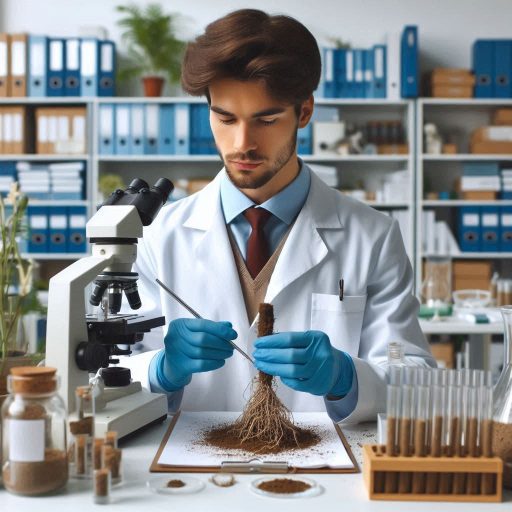Introduction
Soil science plays a crucial role in understanding the environment and supporting agriculture.
Healthy soils contribute to food security, ecosystem stability, and biodiversity.
Soil scientists study soil properties, processes, and interactions with plants, water, and climate.
Their work helps develop sustainable practices that enhance soil health and productivity.
As global challenges like climate change and population growth escalate, soil science evolves to address these issues.
New technologies and interdisciplinary approaches emerge to improve soil management and conservation.
Researchers focus on sustainable practices that restore degraded soils and enhance their resilience.
In recent years, there has been an increased emphasis on soil health.
This shift recognizes that healthy soils are vital for agricultural sustainability and environmental protection.
Additionally, scientists are exploring the impact of emerging contaminants and the importance of regenerative agriculture.
As trends in soil science continue to evolve, professionals must adapt their strategies and methods.
The future of soil science depends on understanding these trends and implementing innovative solutions.
By embracing change, soil scientists can help ensure a sustainable future for our planet and its resources.
Increased focus on soil health
Shift Towards Sustainable Soil Management Practices
Soil health has become a priority in modern agriculture and environmental management.
Researchers, farmers, and policymakers increasingly recognize the importance of healthy soils.
This shift reflects a broader awareness of soil’s critical role in sustaining ecosystems, agriculture, and food security.
Sustainable soil management practices promote soil health.
These practices aim to improve soil structure, nutrient content, and biodiversity.
They emphasize minimizing soil disturbance, optimizing organic matter, and maintaining ground cover.
As a result, farmers can increase crop yields while preserving soil integrity.
One emerging trend is the adoption of regenerative agriculture.
This approach focuses on restoring soil health through practices like cover cropping, crop rotation, and reduced tillage.
These methods enhance soil structure and encourage beneficial microbial activity.
Farmers who adopt these practices often experience improved soil fertility and reduced reliance on chemical fertilizers.
Importance of Soil Conservation and Restoration
Soil conservation is essential for mitigating climate change impacts.
Healthy soils store carbon, helping to reduce greenhouse gas emissions.
Practices such as agroforestry and conservation tillage can enhance soil carbon sequestration.
These approaches not only improve soil health but also contribute to climate resilience.
The importance of soil restoration is gaining traction.
Degraded soils can lead to reduced agricultural productivity and environmental harm.
Restoration practices aim to rehabilitate these damaged soils, enhancing their health and functionality.
Techniques like reforestation, erosion control, and organic amendments play crucial roles in this process.
Collaborative efforts among stakeholders are essential for promoting soil health.
Governments, researchers, and farmers must work together to develop effective soil management strategies.
Policies that incentivize sustainable practices can encourage broader adoption.
Education and training programs can also empower farmers to implement soil health practices successfully.
Moreover, technological advancements are aiding the focus on soil health.
Precision agriculture allows farmers to monitor soil conditions closely.
Data-driven approaches enable tailored management practices that optimize soil health and productivity.
Farmers can use soil sensors and satellite imagery to gather valuable insights for decision-making.
The growing emphasis on soil health also aligns with consumer demand for sustainable food systems.
As consumers become more conscious of environmental issues, they prefer products that support sustainable practices.
This shift encourages farmers to adopt soil health practices to meet market expectations.
The increased focus on soil health reflects a significant trend in soil science.
Sustainable soil management practices, conservation, and restoration are vital for future agricultural success.
By prioritizing soil health, we can ensure a resilient and productive agricultural system for generations to come.
Read: Challenges and Rewards: The Dual Life of an U.S. Environmental Scientist
Advancements in technology
How Technology is Enhancing Soil Analysis and Monitoring
Technology is revolutionizing soil science by improving soil analysis and monitoring.
Innovative tools enhance the accuracy and efficiency of soil assessments.
These advancements enable scientists and farmers to make informed decisions based on real-time data.
Remote sensing technologies are crucial in monitoring soil health.
Satellites and drones collect valuable data on soil properties over large areas.
This technology allows for the assessment of soil moisture, temperature, and organic matter levels.
With remote sensing, researchers can identify areas needing intervention and monitor changes over time.
Soil sensors are another significant advancement.
These sensors measure various soil parameters, such as pH, moisture, and nutrient levels.
They provide real-time data, allowing farmers to manage their soils more effectively.
For example, moisture sensors can help optimize irrigation practices, reducing water waste and improving crop yields.
Data analytics plays a vital role in soil science advancements.
Advanced software processes large datasets to extract meaningful insights.
These insights enable researchers to identify patterns and trends in soil health.
Predictive models can help forecast soil behavior under various conditions, aiding better land management decisions.
Examples of Innovative Tools and Techniques Being Used in Soil Science Research
Innovative tools and techniques continue to emerge in soil science research.
One example is the use of soil scanning technologies.
Portable X-ray fluorescence (XRF) analyzers allow for rapid, on-site analysis of soil composition.
Researchers can obtain immediate results, enabling quick adjustments to soil management strategies.
Another innovation is the use of artificial intelligence (AI) in soil science.
AI algorithms analyze data collected from sensors and remote sensing technologies.
These algorithms help identify correlations and optimize soil management practices.
By integrating AI, scientists can predict soil behavior more accurately and develop tailored recommendations.
Machine learning is also enhancing soil analysis.
Researchers use machine learning models to classify soils based on various attributes.
This process improves the understanding of soil types and their potential uses.
It enables more efficient land-use planning and resource allocation.
Soil microbiome research has also benefited from technological advancements.
High-throughput sequencing techniques allow for the detailed analysis of soil microbial communities.
Understanding the soil microbiome can lead to better soil health management practices.
This knowledge can enhance nutrient cycling and disease suppression in agricultural systems.
Furthermore, mobile applications are facilitating soil management for farmers.
These apps provide access to soil data, recommendations, and best practices.
Farmers can use this information to make informed decisions about soil management.
This accessibility empowers them to implement sustainable practices effectively.
Advancements in technology are transforming soil science.
Innovative tools enhance soil analysis and monitoring, leading to better decision-making.
By embracing these technologies, scientists and farmers can promote soil health and sustainable agriculture.
The future of soil science is bright, driven by these technological advancements.
Read: Job Market Trends: Future of Chemistry Jobs in America
Climate change implications on soil science
How Climate Change is Impacting Soil Health
Climate change significantly affects soil health across the globe.
Increased temperatures lead to changes in soil moisture levels.
These alterations can disrupt microbial communities that play essential roles in nutrient cycling.
Changes in precipitation patterns cause soil erosion and degradation, further diminishing soil quality.
Extreme weather events also contribute to soil health challenges.
Floods can wash away fertile topsoil, reducing agricultural productivity.
Droughts can lead to soil compaction and desertification, making recovery difficult.
These events highlight the vulnerability of soils to climate-related impacts.
Additionally, rising carbon dioxide levels influence soil processes.
Higher CO2 concentrations can enhance plant growth, but they may also affect soil composition.
Elevated CO2 can alter the balance of nutrients in the soil, leading to deficiencies or toxicities.
This imbalance can jeopardize crop health and yield.
Soil temperature changes due to climate change also impact organic matter decomposition.
Warmer soils can accelerate decomposition, releasing stored carbon back into the atmosphere.
This release contributes to greenhouse gas emissions, further exacerbating climate change.
Strategies for Mitigating the Effects of Climate Change on Soil
To combat climate change impacts on soil health, several strategies are essential.
First, implementing sustainable land management practices can improve soil resilience.
Practices such as crop rotation, cover cropping, and reduced tillage enhance soil structure and fertility.
These methods also increase organic matter content, promoting healthy microbial activity.
Second, soil conservation techniques can mitigate erosion and degradation.
Establishing buffer strips along waterways reduces runoff and protects soil from erosion.
Utilizing contour farming and terracing on sloped land can further minimize soil loss.
These practices help maintain soil integrity while promoting sustainable agricultural practices.
Third, enhancing soil carbon sequestration plays a vital role.
Increasing organic matter through composting and agroforestry improves soil health.
It also captures atmospheric carbon, helping to mitigate climate change effects.
Promoting practices that enhance carbon storage can be crucial in addressing climate-related challenges.
Moreover, adopting precision agriculture technologies can optimize resource use.
These technologies allow farmers to apply fertilizers and water more efficiently.
By tailoring inputs to specific soil conditions, farmers can enhance soil health while reducing environmental impacts.
Collaboration among scientists, policymakers, and farmers is also essential.
Research should focus on developing adaptive management strategies to address climate change impacts.
Policymakers must support programs that incentivize sustainable practices and soil conservation efforts.
Lastly, education and outreach initiatives can raise awareness about soil health.
Informing farmers about the importance of soil conservation and sustainable practices can drive change.
Workshops, seminars, and online resources can empower farmers to adopt new strategies.
Climate change poses significant challenges to soil health.
Understanding these impacts is crucial for developing effective mitigation strategies.
By implementing sustainable practices and enhancing collaboration, we can protect our soils for future generations.
Read: Challenges and Rewards: Navigating the Chemist Career Path

Integration of interdisciplinary approaches
Importance of Collaboration Between Different Fields in Soil Science
Integrating interdisciplinary approaches is vital for advancing soil science.
Collaboration between soil scientists and experts from other fields enhances research quality.
It allows for a comprehensive understanding of complex soil issues.
Engaging with ecologists, agronomists, and environmental scientists fosters innovative solutions.
Interdisciplinary collaboration facilitates the exchange of knowledge and techniques.
Soil scientists can learn from adjacent fields, incorporating diverse methodologies into their research.
This blending of perspectives leads to more effective problem-solving.
For instance, utilizing data analytics from computer science can improve soil analysis accuracy.
Moreover, interdisciplinary approaches can address pressing global challenges.
Climate change, food security, and biodiversity loss require coordinated efforts across multiple disciplines.
Soil scientists must work alongside climate scientists to understand soil-climate interactions.
This collaboration can inform strategies for mitigating climate impacts on soil health.
Partnerships with social scientists also play a crucial role.
Understanding human behavior and decision-making processes enhances soil conservation initiatives.
Engaging communities in sustainable practices requires insights from sociology and psychology.
These collaborations promote effective outreach and education strategies.
Examples of How Incorporating Diverse Perspectives Can Lead to New Discoveries
Several examples illustrate how interdisciplinary collaboration leads to new discoveries in soil science.
One notable instance involves using remote sensing technology in soil mapping.
By partnering with geographers and engineers, soil scientists can obtain detailed spatial data.
This information aids in understanding soil variability across landscapes.
Another example is the integration of molecular biology techniques in soil research.
Collaborating with microbiologists allows for a deeper understanding of soil microbial communities.
Analyzing soil DNA helps identify beneficial microbes and their roles in nutrient cycling.
This knowledge can inform sustainable agriculture practices.
Additionally, integrating economics into soil science research can provide insights into the costs of soil degradation.
Understanding the economic implications of soil health encourages investment in sustainable practices.
Collaboration with economists can help develop financial models that support soil conservation.
Innovative practices also emerge from interdisciplinary approaches.
For example, combining soil science with landscape architecture can enhance urban soil management.
Creating green spaces and sustainable landscapes requires knowledge of soil health.
This collaboration promotes urban resilience and ecological balance.
Furthermore, educational institutions increasingly emphasize interdisciplinary training.
Programs that combine soil science with environmental policy or agricultural technology prepare students for diverse careers.
Graduates equipped with interdisciplinary skills can tackle complex soil-related challenges effectively.
Integrating interdisciplinary approaches is essential for advancing soil science.
Collaboration between various fields fosters innovation and enhances research outcomes.
By combining diverse perspectives, soil scientists can address global challenges and make significant contributions to sustainability.
Emphasizing interdisciplinary collaboration will drive future discoveries and ensure healthier soils for generations to come.
Read: Diverse Career Paths: From Chemist to Patent Attorney in the US
Emerging Contaminants in Soil
Presence of New Pollutants in Soil
Emerging contaminants pose significant risks to soil health and ecosystems.
These pollutants include pharmaceuticals, personal care products, and industrial chemicals.
As urbanization and industrial activities increase, so does soil contamination.
Conventional pollutants like heavy metals and pesticides remain critical concerns, but new contaminants require urgent attention.
Many emerging contaminants enter the soil through wastewater discharge and agricultural runoff.
Fertilizers and pesticides may contain unregulated substances.
Landfills and hazardous waste sites also contribute to soil contamination.
Contaminated soil can affect plant growth and disrupt food chains.
Research indicates that emerging contaminants can persist in soil for extended periods.
Their complex chemical structures make them challenging to degrade.
Some contaminants accumulate in soil organisms, leading to bioaccumulation in the food web.
Consequently, these pollutants pose risks to human health and the environment.
Understanding the presence and behavior of emerging contaminants in soil is essential.
Soil scientists must conduct thorough assessments to identify these pollutants.
This requires developing innovative analytical techniques to detect low concentrations of contaminants.
High-resolution mass spectrometry and advanced chromatography are effective tools in this effort.
Strategies for Detecting and Remedying Soil Contamination
Implementing effective strategies is crucial for detecting and remedying soil contamination.
First, establishing robust monitoring programs can help identify emerging contaminants.
Regular soil sampling and analysis provide valuable data on pollutant levels.
Monitoring allows for timely intervention before contaminants spread further.
Next, researchers should develop standardized protocols for detecting emerging contaminants.
Consistency in sampling methods and analysis will enhance data comparability.
Furthermore, scientists must collaborate with environmental agencies to establish regulatory frameworks for monitoring pollutants.
In addition, innovative remediation technologies can help address soil contamination.
Bioremediation utilizes microorganisms to degrade pollutants naturally.
This method offers an eco-friendly approach to cleaning contaminated soils.
Phytoremediation involves planting specific species that can absorb or stabilize contaminants in the soil.
Chemical remediation methods also play a role in addressing soil contamination.
Soil washing, stabilization, and encapsulation can effectively remove or immobilize contaminants.
These techniques often require careful planning and site-specific considerations.
Education and outreach are essential components of effective contamination management.
Engaging with farmers, industries, and communities can promote awareness of emerging contaminants.
Providing resources and training can empower stakeholders to adopt sustainable practices.
Collaboration among scientists, policymakers, and industry professionals is vital.
This collective effort can drive research on emerging contaminants and develop best practices for soil management.
Establishing partnerships can also facilitate funding opportunities for research and remediation projects.
Addressing emerging contaminants in soil is a pressing issue.
Understanding their presence and behavior is crucial for effective management.
Implementing monitoring programs, standardized detection protocols, and innovative remediation strategies will help mitigate soil contamination.
With collaborative efforts, we can protect soil health and ensure a sustainable future for our ecosystems.
Focus on regenerative agriculture
How Regenerative Agriculture Practices Can Improve Soil Health
Regenerative agriculture focuses on improving soil health through sustainable practices.
These practices prioritize soil regeneration, biodiversity, and ecosystem resilience.
By enhancing soil quality, regenerative agriculture increases agricultural productivity over time.
Key practices include cover cropping, crop rotation, and reduced tillage.
Cover cropping involves planting specific crops during off-seasons.
These crops protect the soil from erosion and improve soil structure.
They also enhance organic matter content and encourage beneficial microbial activity.
As a result, cover crops contribute to better nutrient cycling.
Crop rotation helps maintain soil fertility and disrupt pest cycles.
By alternating crops, farmers can reduce the reliance on chemical fertilizers and pesticides.
Rotating crops improves biodiversity in the soil and promotes a healthy ecosystem.
This method leads to healthier plants and higher yields.
Reduced tillage minimizes soil disturbance, preserving its structure and organic matter.
Tillage can degrade soil quality by causing erosion and compaction.
By adopting reduced tillage practices, farmers can enhance soil moisture retention.
This practice promotes a more resilient agricultural system.
Additionally, regenerative agriculture emphasizes integrating livestock into farming systems.
Managed grazing allows animals to contribute organic matter through manure.
This practice enriches soil health and promotes nutrient cycling.
Furthermore, livestock can help control weeds and pests naturally.
Case Studies of Successful Regenerative Agriculture Projects
Several case studies highlight the success of regenerative agriculture practices.
One notable example is the Rodale Institute in Pennsylvania, USA.
Their long-term research demonstrates improved soil health through regenerative methods.
After implementing cover crops and reduced tillage, they observed a significant increase in soil organic matter.
Another success story comes from the Savory Institute, which promotes holistic grazing practices.
Their work in Zimbabwe shows how managed grazing can restore degraded grasslands.
This approach improves soil health while increasing biodiversity and carbon sequestration.
Farmers report enhanced pasture productivity and improved water retention.
In Australia, the Australian National University showcases regenerative agriculture’s potential.
Researchers implemented diverse crop rotations and cover cropping on farms.
They found that these practices significantly improved soil health and reduced erosion.
Farmers adopting these methods reported higher crop yields and improved resilience to climate variability.
Furthermore, in California, the Soil Health Initiative works with farmers to implement regenerative practices.
By focusing on soil health, they achieve better water retention and improved crop resilience.
Farmers involved in the initiative report reduced reliance on synthetic inputs and increased profitability.
Regenerative agriculture practices also promote community engagement and knowledge sharing.
Farmers collaborating in local networks learn from each other’s experiences.
This shared knowledge fosters innovation and enhances the adoption of regenerative practices.
Regenerative agriculture offers promising solutions for improving soil health.
By implementing practices such as cover cropping, crop rotation, and reduced tillage, farmers can enhance soil quality.
Successful case studies demonstrate the effectiveness of these practices in various contexts.
As more farmers adopt regenerative agriculture, we can promote a sustainable future for our ecosystems and food systems.
Future career opportunities in soil science
Potential Job Prospects in the Field
Soil science offers a diverse range of career opportunities.
As environmental concerns grow, the demand for soil scientists continues to increase.
Various sectors require expertise in soil management, conservation, and analysis.
Career paths for soil scientists include research, academia, consulting, and government positions.
In academia, soil scientists can pursue teaching and research roles.
Universities seek qualified individuals to educate the next generation of students.
Research opportunities abound in soil health, sustainable agriculture, and environmental science.
Professors can secure grants to fund innovative projects, advancing knowledge in the field.
Government agencies also hire soil scientists for various roles.
These positions may involve conducting soil surveys, managing land resources, or developing environmental policies.
Soil scientists in government help implement regulations to protect soil and water quality.
Their expertise ensures compliance with environmental standards and promotes sustainable land use.
Private consulting firms employ soil scientists to advise landowners and businesses.
Consultants assess soil conditions, recommend management practices, and support environmental assessments.
They often work on agricultural projects, helping farmers optimize crop production while conserving soil health.
This role requires strong communication skills to convey complex information to clients.
Non-profit organizations increasingly seek soil scientists to address environmental issues.
These organizations focus on soil conservation, restoration, and education.
Soil scientists in this sector may conduct outreach programs, promote sustainable practices, or lead community engagement initiatives.
Growing Demand for Soil Scientists in Various Industries
The demand for soil scientists is rising due to several factors.
Climate change and environmental degradation highlight the need for sustainable practices.
As soil health directly impacts food security and ecosystem resilience, industries require knowledgeable professionals.
Agriculture remains a primary employer of soil scientists.
As farmers face challenges from climate change, they seek ways to enhance soil fertility and productivity.
Soil scientists provide guidance on crop rotation, cover cropping, and nutrient management.
Their expertise helps farmers adapt to changing conditions while maintaining yields.
Environmental consulting firms also experience increased demand for soil scientists.
Businesses and governments need soil assessments for land development and remediation projects.
Soil scientists evaluate contamination levels, recommend cleanup strategies, and ensure regulatory compliance.
This work is essential for safeguarding public health and the environment.
Additionally, soil scientists play a crucial role in urban planning.
As cities expand, sustainable land use practices become vital.
Soil scientists assess soil suitability for construction, green infrastructure, and landscaping.
Their insights contribute to informed decision-making for urban development.
Research institutions are also hiring soil scientists to address pressing issues.
Topics like climate change, soil carbon sequestration, and biodiversity require in-depth study.
Soil scientists contribute to innovative solutions, enhancing our understanding of soil systems.
The future of soil science holds exciting career opportunities.
With increasing demand in agriculture, government, consulting, and research, the field offers diverse paths.
As environmental challenges grow, soil scientists will play a vital role in promoting sustainable practices and protecting our natural resources.
Investing in soil science education and training will ensure a bright future for this essential profession.
Delve into the Subject: Famous Space Scientists and Their Contributions
Transform Your Career Today
Unlock a personalized career strategy that drives real results. Get tailored advice and a roadmap designed just for you.
Start NowFind Out More: How Geologists Study Earthquakes and Fault Lines
Conclusion
The future of soil science presents exciting trends and opportunities.
Increased focus on soil health drives sustainable management practices.
Technological advancements enhance soil analysis and monitoring capabilities.
Climate change implications highlight the need for effective mitigation strategies.
Interdisciplinary approaches foster collaboration and innovation in the field.
Emerging contaminants pose new challenges, requiring strategies for detection and remediation.
Regenerative agriculture practices improve soil health and restore ecosystems.
Additionally, the growing demand for soil scientists across various industries opens up numerous career paths.
Individuals interested in pursuing a career in soil science can make a significant impact.
They can contribute to environmental protection, agricultural sustainability, and resource management.
Education and training in soil science will prepare future professionals for these essential roles.
We encourage aspiring soil scientists to explore educational programs and research opportunities.
Engaging in internships or volunteering can provide valuable experience.
Networking with professionals in the field can open doors to new possibilities.
By pursuing a career in soil science, individuals can help address pressing global challenges.
Their work will promote sustainable practices and safeguard our planet‘s health for future generations.
Join the movement to advance soil science and its vital contributions to society.




